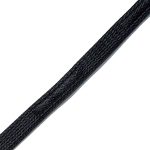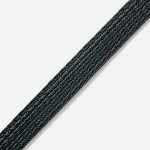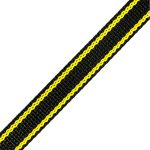Leading Edge Webbing
High-Performing Leading-Edge Webbing Manufacturer
As a trusted webbing manufacturer for the fall protection industry, we’re proud to offer leading edge self-retracting lifeline webbing and traditional lanyard webbing for leading edge situations—replacing the heavy, impractical cable. We’ve leveraged our years of expertise to engineer a better solution: leading edge webbing, specifically manufactured to prevent breakage from sharp edges on rooftops and platforms; just like cable, only without the additional weight.
Due to the critical use and application as leading edge fall protection, Sturges routinely and thoroughly tests each webbing production lot dynamically over a steel .005” radius edge per the ASSP/ANSI Z359.14 specification performing both the perpendicular and offset drop, all conducted in-house. In addition, Sturges also weaves a variety of patented tear webbings to regulate the force in leading-edge applications.
Below is just a small sampling of the products that we offer. Don’t see a product that will meet your requirements? Please reach out to our team. We have made custom solutions for original equipment manufacturers for over 100 years. We would be more than happy to offer our expertise to develop a product that meets your exact specifications.
Leading Edge Webbing Products
This is just a small sampling of the products that we offer. Don’t see a product that will meet your requirements? Please reach out to our team. We have made custom solutions for original equipment manufacturers for over 100 years. We would be more than happy to offer our expertise to develop a product that meets your exact specifications.
Leading Edge Fall Protection: Keeping Safety a Priority
Leading and sharp-edge applications pose a significant risk for cut, frayed, or severed lifelines. Especially when working at heights such as on a roof several stories in the air, this puts workers in danger of severe injury. As experts in webbing used in fall protection, few things matter as much to our engineers as making safety a priority when working at height.
Leading edge lanyards and leading edge self-retracting lifelines (SRLs) are major ways that professionals stay safe, but both of these traditional leading edge products are made with bulky steel cables. On one hand, these cables make sense to prevent severing or breaking, but it’s clear to everyone in the industry that in actual execution, these cables are heavy and cumbersome.
Our leading edge webbing is carefully engineered and extensively tested in our state-of-the-art, in house testing facility, which means we can provide you with pre-tested webbing products to save you time and accelerate speed to market for leading edge fall protection products.
Looking For An Alternative To Steel Cable?
As a trusted webbing manufacturer for the Fall Protection industry, we’re proud to offer Leading Edge Self-Retracting Lifeline webbing and traditional lanyard webbing for Leading Edge situations in place of cable.
View our Leading Edge Case Study to learn more about our tested & reliable alternative to traditional steel cables.
This case study takes an in-depth look at how leading edge webbing, a relatively new product to the leading edge fall protection market, requires extensive studies to prove its market readiness and instill confidence.
Sturges understands that like any other critical, lifesaving product, this webbing must undergo thorough testing to meet safety regulations, which is why every production lot at Sturges undergoes the most stringent testing.
“Leading edge self retracting lifelines have traditionally been designed with heavy steel cables as it was a proven product that could pass the ANSI/ASSP Z359.14-2014 Standard. Until recently, there were no alternate materials that could be used to pass this rigorous test.”
Leading-Edge Webbing Applications
Leading-edge webbing is designed to enhance safety in environments where workers are exposed to fall hazards. Its high strength, abrasion resistance, and durability make it a critical component in various fall protection systems. Mainly used to create fall arrest systems, leading-edge webbing provides an additional layer of protection for workers at heights.
Leading-edge webbing for Fall Arrest Systems
Leading-edge webbing is a key material in self-retracting lifelines (SRLs) and lanyards designed for leading-edge applications. These systems protect workers when a fall may occur over an edge, such as rooftops, steel structures, or unfinished concrete surfaces. The webbing is engineered to withstand sharp-edge impact and minimize the risk of failure in case of a fall.
FAQs About The Benefits & Features of Leading-Edge Webbing
In the Fall Protection industry, few things are as important and highly prioritized as safety at height. Whether working on a telephone pole or a roof many stories above the ground, creating a safe environment for the worker is crucial.
In order to meet the unique needs of the industry, Leading Edge Self Retracting Lifelines (SRLs) were developed. Traditionally, these SRLs have been designed with heavy steel cables to protect a worker from a fall over a sharp edge. With the latest development in performance webbings, there is now a lightweight alternative to the steel cable SRL.
What is adequate edge protection?
Edge protection is a vital safety measure on construction sites, roofing projects, and other situations where workers are exposed to falls. There are different types of edge protection products in the industry. In addition to steel cable, they can also use leading-edge webbing.
This type of webbing is a component in Leading Edge Self Retracting Lifelines (SRLs) and lanyards, which connect the worker to an anchor point to prevent serious injuries in case of a fall. Leading-edge webbing is typically made from high-strength synthetic material, such as Kevlar, and is designed to withstand sharp edges.
What does is mean for webbing and SRLs to be "leading edge"?
Per OSHA 1926.751, Leading Edge is defined as “the unprotected side and edge of a floor, roof, or formwork for a floor or other walking/working surface (such as a deck).” These unprotected edges leave workers suspended above them in a potentially precarious position.
The presence of this edge creates an additional hazard — if someone falls and their SRL hits this unprotected edge, the combination of velocity, weight, and the sharpness of the corner is likely to snap a standard SRL not rated for leading-edge applications.
What does the process for developing leading-edge webbing entail?
In the initial design phase at Sturges Manufacturing, testing goes beyond the requirements of the ASSP/ANSI Z359.14 in several key ways. Samples are abraded per FED STD 191A, Method 5309 and then dropped 6’5” using the ASSP/ANSI Z359.14 requirement with a 310 lb test mass and tested in a fixed position without an SRL. After the dynamic test is complete in both the off-set and perpendicular position and the weight has been held for 2 minutes, the weight is pushed again to swing more on the edge for 5 additional minutes in multiple directions to ensure it can withstand the increased exposure over time. Once the sample is removed from the leading-edge test tower, it is then tested statically to verify the strength exceeds 1,000 lbs.
Sturges is able to design prototypes and test them in-house in its state-of-the-art testing facility. The ability to test in-house also allows Sturges to provide a pre-tested product to clients during new product development saving time and increasing their speed to market.
While Sturges is focused on convenience for the customer, their own process remains detailed and custom — Sturges does not use another customer’s in-house results to market to other customers. Each prototype is unique and receives its own test data.
With safety being first, Sturges doesn’t only test during the design stage, but regularly during production as well. Dynamic testing is performed daily with each production run and monitored through SPC to ensure a quality webbing that can be depended on.
Can Leading Edge Webbing be Branded?
Leading Edge webbing can be customized to include custom colors and patterns. Sturges Manufacturing’s design and engineering teams work with customers to develop webbing that functions as intended and incorporates necessary branding.
Kevlar® and Nomex® are registered trademarks of the E. I. du Pont de Nemours and Company
Dyneema® is a registered trademark of Avient Protective Materials.
Vectran® is a registered trademark of Kuraray America, Inc.
Ensorba® is a registered trademark of Sturges Manufacturing Co., Inc.



